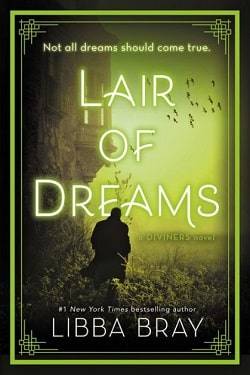Lair of Dreams, the second installment in Libba Bray's acclaimed series The Diviners, plunges readers back into the vibrant and haunting world of 1920s New York City. Following the events of the first book, Bray masterfully weaves a tale that explores the complexities of dreams, identity, and the shadows that lurk beneath the surface of a seemingly glamorous society. This sequel not only expands on the rich mythology established in the first book but also deepens the emotional resonance of its characters, making it a compelling read for both fans of the series and newcomers alike.
At the heart of the narrative is Evie O’Neill, who has embraced her identity as a Diviner, a person gifted with supernatural abilities. Now dubbed “America’s Sweetheart Seer,” Evie revels in her newfound fame, yet this adoration comes with its own set of challenges. Bray expertly captures the duality of Evie’s character—her desire for acceptance and her struggle with the responsibilities that come with her powers. The author’s portrayal of Evie’s journey is a poignant exploration of the price of fame and the loneliness that often accompanies it. As Evie navigates her public persona, readers witness her internal conflicts, which are beautifully rendered through Bray’s evocative prose.
Alongside Evie, we meet two new Diviners: Henry DuBois and Ling Chan. Henry, a piano prodigy, grapples with his own demons as he searches for a lost love, while Ling, a Chinese-American girl, faces the societal pressures of a world that marginalizes her. Their stories are interwoven with Evie’s, creating a rich tapestry of experiences that highlight the diverse struggles of the characters. Bray’s ability to give each character a distinct voice and arc is commendable; she delves into themes of love, loss, and the quest for belonging, making them relatable and engaging.
The introduction of a mysterious sleeping sickness that plagues the city adds a layer of urgency to the plot. As victims succumb to this ailment, the stakes rise, and the Diviners must confront a malevolent force that threatens not only their lives but the very fabric of their dreams. Bray’s exploration of dreams as both a sanctuary and a battleground is particularly striking. The dreamworld serves as a metaphor for the characters’ innermost fears and desires, and Bray’s vivid descriptions transport readers into this surreal landscape, where the line between reality and fantasy blurs.
Bray’s writing is rich with historical detail, immersing readers in the sights and sounds of 1920s New York. The city itself becomes a character, with its jazz clubs, speakeasies, and bustling streets serving as a backdrop for the unfolding drama. This setting not only enhances the atmosphere but also reflects the societal changes of the era, including the struggles for racial and gender equality. Bray’s commitment to authenticity is evident, and her ability to weave historical context into the narrative adds depth to the story.
One of the most compelling aspects of Lair of Dreams is its exploration of the concept of dreams as a collective experience. The idea that dreams can connect individuals, especially in times of crisis, resonates throughout the narrative. Bray poses thought-provoking questions about the nature of dreams and their impact on reality, inviting readers to reflect on their own experiences. This thematic depth sets the book apart from other young adult fantasy novels, elevating it to a level that encourages critical thinking and introspection.
Character development is another area where Bray excels. Each character faces their own challenges and undergoes significant growth throughout the story. Evie’s evolution from a carefree girl seeking fame to a more self-aware individual grappling with her responsibilities is particularly well-executed. Similarly, Henry and Ling’s journeys are marked by personal revelations that resonate with readers on a profound level. Bray’s ability to create multi-dimensional characters who confront their fears and desires makes the story not only engaging but also emotionally impactful.
The pacing of the novel is well-balanced, with moments of tension interspersed with quieter, introspective scenes that allow for character development. Bray’s knack for suspense keeps readers on the edge of their seats, particularly as the mystery surrounding the sleeping sickness unfolds. The plot twists are cleverly crafted, ensuring that the story remains unpredictable and captivating until the very end.
In comparison to other works in the young adult fantasy genre, Lair of Dreams stands out for its intricate world-building and character-driven narrative. Readers who enjoyed works like The Raven Boys by Maggie Stiefvater or The Night Circus by Erin Morgenstern will find much to love in Bray’s writing. Both authors share a penchant for blending the fantastical with the real, creating immersive worlds that linger in the reader’s mind long after the last page is turned.
In conclusion, Lair of Dreams is a triumph of storytelling that delves into the complexities of dreams, identity, and the human experience. Libba Bray’s masterful prose, rich character development, and thematic depth make this sequel a worthy continuation of The Diviners series. As readers journey through the mystical underbelly of New York City, they are treated to a tale that is both enchanting and thought-provoking. This book is a must-read for anyone seeking a blend of historical fiction, fantasy, and a touch of the supernatural.
























Reviews 0
Post a Reviews: